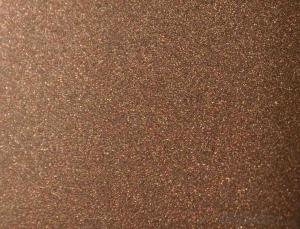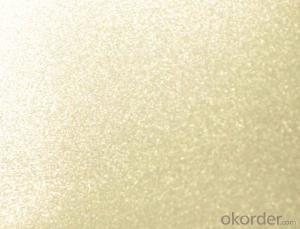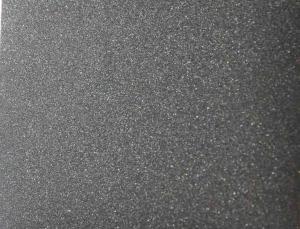Bead Blasted Series
- Loading Port:
- China Main Port
- Payment Terms:
- TT OR LC
- Min Order Qty:
- -
- Supply Capability:
- -
OKorder Service Pledge
Quality Product, Order Online Tracking, Timely Delivery
OKorder Financial Service
Credit Rating, Credit Services, Credit Purchasing
You Might Also Like
Bead Blasted Series
Material:SUS304 SUS430 SUS316
Specification:1219mm*2438mm
Thickness:0.7mm-3.0m
Finish:BA,2B,Mirror
Other Specification:
Special sizes can be supplied by customers’ requests
Product Characteristic:
We imported an automatic bead blast production line and particular parameter, ensuring the sheets even and present pearl silver luster. let the bead blasted sheet be a high quality and wild range use of new building material.
Application:
Elevator,Architectural Decoration,Subway Station,Public Utility,Electrical Equipment.
- Q:What is the composition of stainless steel sheets?
- Stainless steel sheets are primarily composed of iron, chromium, and varying amounts of other elements such as nickel, manganese, and carbon. The main component, iron, provides the strength and durability of the sheets, while chromium is added to enhance corrosion resistance. The addition of nickel increases the sheets' resistance to high temperatures and improves their overall mechanical properties. Manganese is added to enhance the sheets' formability, and carbon is added to improve their hardness. These elements work together to create a versatile and highly reliable material that is commonly used in various industries, including construction, automotive, and manufacturing.
- Q:Are stainless steel sheets suitable for cleanroom applications?
- Yes, stainless steel sheets are suitable for cleanroom applications. Stainless steel has excellent corrosion resistance, which is important in cleanroom environments where cleanliness and hygiene are crucial. It is also highly durable and easy to clean, making it ideal for maintaining cleanliness standards in cleanrooms. Additionally, stainless steel is non-porous, which means it does not absorb contaminants and can be easily sanitized. It is also resistant to chemicals, making it suitable for cleanroom applications where strong disinfectants or cleaning agents may be used. Overall, stainless steel sheets offer a reliable and hygienic surface for cleanroom applications.
- Q:What are the cost considerations when purchasing stainless steel sheets?
- When purchasing stainless steel sheets, there are several cost considerations to keep in mind. Firstly, the grade of stainless steel will greatly impact the cost. Stainless steel is available in various grades, with each grade possessing different properties and levels of corrosion resistance. Higher grades such as 316 or 304 tend to be more expensive due to their superior corrosion resistance and durability. The size and thickness of the stainless steel sheets also affect the cost. Thicker sheets generally cost more than thinner ones, and larger sheets will be priced higher than smaller ones. It is important to accurately determine the required size and thickness to avoid unnecessary expenses. Surface finish is another factor that can influence the cost. Stainless steel sheets come in a range of finishes, such as brushed, mirror, or matte. Finishes that require additional processing or polishing will usually add to the overall cost. Additionally, the quantity of sheets needed can impact pricing. Bulk purchases often offer discounts or lower per-unit costs compared to buying small quantities. Transportation and delivery costs should also be considered. Stainless steel sheets are heavy and can be expensive to transport, especially if shipping long distances. It is important to factor in these costs to ensure the overall purchase remains within budget. Lastly, it is crucial to consider the reputation and reliability of the supplier. While lower-priced options may be tempting, it is important to ensure that the supplier provides high-quality stainless steel sheets that meet the required specifications. Purchasing from a reputable supplier may come at a slightly higher cost, but it guarantees the quality and reliability of the product. Overall, when purchasing stainless steel sheets, it is vital to consider the grade, size, thickness, surface finish, quantity, transportation costs, and the reputation of the supplier. By carefully considering these factors, one can make an informed decision that balances cost-effectiveness with the desired quality and specifications.
- Q:Are stainless steel sheets suitable for heat exchangers?
- Yes, stainless steel sheets are suitable for heat exchangers. Stainless steel has excellent thermal conductivity, which means it can efficiently transfer heat between fluids. Additionally, stainless steel is highly resistant to corrosion and oxidation, making it ideal for applications where it will come into contact with various fluids or gases at different temperatures. Its durability and ability to withstand high temperatures also make it a reliable choice for heat exchangers. Overall, stainless steel sheets are a popular and reliable material for heat exchangers due to their thermal conductivity, corrosion resistance, and durability.
- Q:What's the surface of the 304 stainless steel matte board?
- NO.2B gloss is stronger than NO.2D NO.2D, after processing, through the polishing roller, eventually a slight cold rolling, in order to obtain proper luster. This is the most commonly used surface finish, which can also be used as the first step in polishing. General timberBA is bright as a mirror but has no standard, but is usually bright annealed and has a high surface reflectivity. Building materials, Kitchenware
- Q:Can stainless steel sheets be used for electromagnetic compatibility?
- Yes, stainless steel sheets can be used for electromagnetic compatibility. Stainless steel has excellent electrical conductivity and high magnetic permeability, which helps in shielding electromagnetic interference (EMI) and radio frequency interference (RFI). It is commonly used in applications where electromagnetic compatibility is required, such as enclosures, cabinets, and shielding components in electronic devices.
- Q:Can stainless steel sheets be used for architectural railings?
- Yes, stainless steel sheets can be used for architectural railings. Stainless steel is known for its durability, corrosion resistance, and aesthetic appeal, making it a popular choice for architectural applications such as railings. It offers strength and stability while also adding a sleek and modern look to any structure.
- Q:Can stainless steel sheets be used in high-temperature applications?
- Indeed, high-temperature applications can utilize stainless steel sheets. Renowned for its superb heat resistance characteristics, stainless steel proves itself adaptable in environments boasting elevated temperatures. Notably, it boasts a formidable melting point, ensuring its durability and structural integrity endure even under extreme conditions. Furthermore, stainless steel showcases commendable oxidation resistance, thwarting scale formation and preserving its surface's sleekness. Consequently, stainless steel sheets rank favorably when considering their widespread employment in diverse high-temperature settings, encompassing heat exchangers, furnaces, boilers, and exhaust systems.
- Q:Are stainless steel sheets suitable for outdoor staircases?
- Yes, stainless steel sheets are suitable for outdoor staircases. Stainless steel is a durable material that is resistant to corrosion and extreme weather conditions, making it an excellent choice for outdoor applications. Additionally, stainless steel sheets can be easily cleaned and maintained, ensuring their longevity and aesthetic appeal.
- Q:How do you prevent discoloration on stainless steel sheets?
- To prevent discoloration on stainless steel sheets, it is essential to avoid exposure to corrosive substances, such as salt, bleach, and strong acids. Regular cleaning with mild soap and water, followed by thorough drying, can help maintain the stainless steel's appearance. Additionally, applying a protective coating or using specialized cleaning products made for stainless steel can provide an extra layer of defense against discoloration.
1. Manufacturer Overview |
|
|---|---|
| Location | |
| Year Established | |
| Annual Output Value | |
| Main Markets | |
| Company Certifications | |
2. Manufacturer Certificates |
|
|---|---|
| a) Certification Name | |
| Range | |
| Reference | |
| Validity Period | |
3. Manufacturer Capability |
|
|---|---|
| a)Trade Capacity | |
| Nearest Port | |
| Export Percentage | |
| No.of Employees in Trade Department | |
| Language Spoken: | |
| b)Factory Information | |
| Factory Size: | |
| No. of Production Lines | |
| Contract Manufacturing | |
| Product Price Range | |
Send your message to us
Bead Blasted Series
- Loading Port:
- China Main Port
- Payment Terms:
- TT OR LC
- Min Order Qty:
- -
- Supply Capability:
- -
OKorder Service Pledge
Quality Product, Order Online Tracking, Timely Delivery
OKorder Financial Service
Credit Rating, Credit Services, Credit Purchasing
Similar products
New products
Hot products
Hot Searches
Related keywords

































